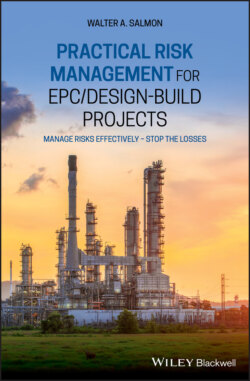Читать книгу Practical Risk Management for EPC / Design-Build Projects - Walter A. Salmon - Страница 21
2.4 EPC Approach 2.4.1 EPC Project Suitability
ОглавлениеAlthough the Design-Build approach can work well with simple Projects, it may not be an entirely suitable procurement route if the proposed facility is complex (with, say, a great deal of emphasis on specialised industrial engineering inputs and proprietary equipment). This is even more true if the final product must also comply with a vast amount of stringent safety regulations and environmental obligations, as well as operational and performance requirements, before being put into use. Where the Employer requires the Contractor to guarantee the quantity and quality of outputs from the completed facility in the operational phase (usually because the Contractor is required to be the entity responsible for selecting, procuring and installing the process equipment), the contractual situation becomes even more complex. Examples of such complex construction work are oil and gas pipelines, oil refineries, petrochemical plants, etc., many of which fall into the mega Project bracket (i.e. over US$1 billion).
For dealing more effectively with such complex Projects, many Employers nowadays consider it best to put as much of the risks of Project success as possible squarely on the shoulders of the Contractor, well beyond the level of risks that would usually be acceptable to a Design-Build Contractor. This is where the Engineering, Procurement, and Construction (EPC) approach comes into its own. It is far better suited for this more complex type of technical/contractual scenario from the Employer's standpoint, especially where most of the risks are to be transferred to the Contractor. The EPC arrangement also usually avoids the need for the Employer to get involved in all the many complicated interfaces and associated coordination activities that occur between the design phase, the procurement phase and the construction phase. Those interfaces can often become an unwieldy task and an awful burden (especially where utility service providers are involved). It should be noted that use of the EPC approach is not limited to complex engineering work or facilities where proprietary technology is involved. In fact, the EPC approach has also been successfully applied to many different types of construction work, including large-scale developments such as upmarket holiday resorts (often including the full fitting-out requirements, usually under what is known as a ‘turnkey’ arrangement).
Under the EPC approach, the Contractor is, just as under the Design-Build arrangement, still the one-stop shop for all implementation activities beyond the basic design work (including the Detailed Design work and, sometimes, even for undertaking the preceding Front-End Engineering Design [FEED] work). However, the EPC Contractor's responsibility will generally also extend to the suitability (fitness for purpose), functionality, quality, and performance of the finished facility, including the quantity and quality of its outputs (which Ron Douglas has elaborated in a whitepaper).4 This is despite the fact that the Employer's Team will almost inevitably be far more deeply involved in approving the Contractor's work during the implementation process than under a Design-Build approach. Such deeper involvement is primarily needed to ensure that suitable ‘checks and balances’ are employed to confirm, as far as possible, that the completed facility can be operated safely.
Of course, the transfer of such major risks and responsibilities from the Employer to the Contractor inevitably results in higher bid prices for EPC Projects compared with using both the Design-Build and Traditional Contracting approaches. However, many Employers seem happy to settle for that trade-off, in order to gain greater certainty of the overall price to be paid (at the end of the day) and the guaranteed quality of, and outputs from, the completed facility.
